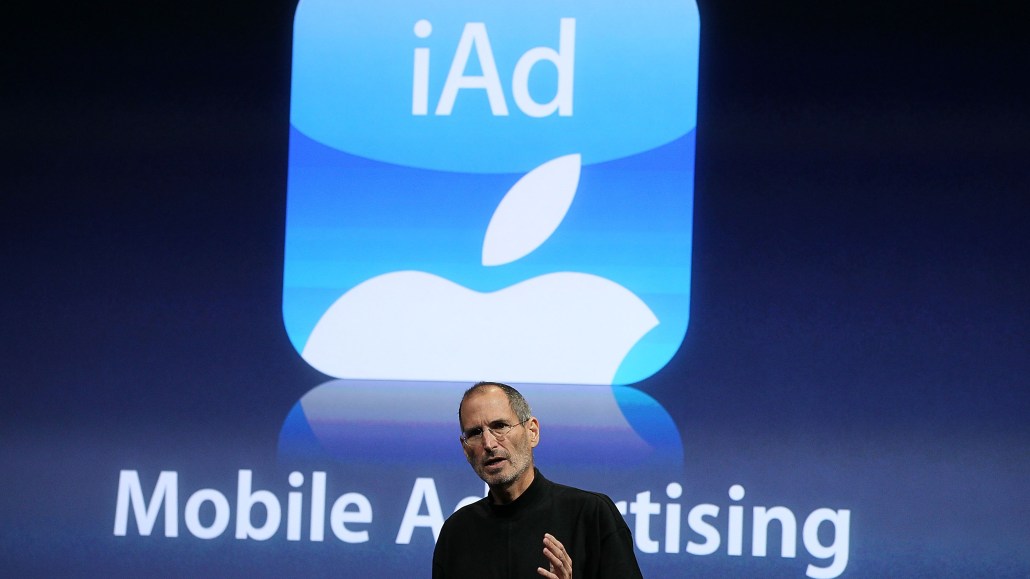
Apple’s iAd network is floundering. Since it launched with major brand partners in late 2010 the mobile ad product has struggled to gain serious traction in a market flooded with similar, yet cheaper, alternatives.
Its market share is already heading in the wrong direction, according to IDC. The research firm estimated Apple will attract 15 percent of total U.S. mobile display ad revenues this year, down from the 19 percent it accounted for in 2010, despite only existing for half of it. The future looks even bleaker for the product if the predictions of IDC vp Karsten Weide prove correct. He predicts Apple will “fade into the background” of the mobile ad market over time. “It hasn’t really worked, so now Apple’s attention turns to more burning issues,” he wrote in a research report.
There were probably outsized expectations. Apple’s entry into the mobile ad space was billed as a seismic change. The veneer of the Apple brand made Quattro, the mobile network Apple bought in January 2010, a hot ticket. That gave iAd a strong start, with a roster of top brands and a hefty price tag of a $1 million minimum for campaigns. Unilever, Geico and Target ran early campaigns.
The bloom soon came off the rose. Apple has been forced to lower its minimum spend requirements and prices repeatedly, as most advertisers balked at its expectations and the initial buzz around it died down. The company’s minimum has dropped by 50 percent. It has also loosened up its stranglehold on the creation of placements, a requirement that rankled agencies and gummed up the process.
In the end, Apple overpromised and underdelivered. It boasted unrivalled creative capabilities, premium inventory, and access to targeting data gleaned through its AppStore. The issue, though, is that rival networks such as Millennial Media and Google-owned AdMob offer similar options, often at considerably lower price points. As the market currently stands, it’s difficult for an advertiser to justify an iAd buy, particularly now that it doesn’t come with a press release, when it can get the same elsewhere, even if it doesn’t come packaged with the Apple brand.
“It’s not that there’s an issue with Apple per se, but having a premium price point in a marketplace that’s still in development means that they can only capture so much investment,” commented David Berkowitz, director of emerging media at digital agency 360i.
Ad position: web_incontent_pos1
Another limitation, as noted by IDC, is that Apple, as is its wont, is an island. It can only serve ads to its own devices. Rival networks, meanwhile, sell inventory across a range of devices, offering marketers greater scale and flexibility.
In an attempt to retain some momentum, Apple continues to invest in the iAd product, though. Contrary to IDCs views, Apple’s sales force has been forging closer links with agencies in an attempt to unlock some of the big-brand budgets they control, and to some extent it seems to be working.
“It’s investing heavily in those relationships, and in understanding the needs of agencies,” said Chia Chen, mobile practice lead at Digitas. Berkowitz said his firm is now in more regular contact with Apple’s sales teams, too, as did Paul Gelb, who heads up mobile for Razorfish. “They’re increasingly working with marketers and agencies to improve the product, and that’s promising,” he said.
According to Chen, Apple probably doesn’t see the iAd as a major revenue driver, though. Its primary purpose is to attract developers to its platform and to drive hardware sales as a result, he suggested.
Even so, in order to serve that function it needs to be selling a substantial portion of the ad inventory publishers are handing it, something it’s failed to do so far. Publishers in the network report average fill rates of around 15 to 20 percent. As a result, they’re forced to work with other networks or sales channels anyway in order to monetize their properties.
Ad position: web_incontent_pos2
“They’ve just entered a completely new business,” said Gelb. “It’s not hardware or software, and there’s a learning curve to it.”
Apple did not respond to requests for comment for this story.
More in Media

NewFronts Briefing: Samsung, Condé Nast, Roku focus presentations on new ad formats and category-specific inventory
Day two of IAB’s NewFronts featured presentations from Samsung, Condé Nast and Roku, highlighting new partnerships, ad formats and inventory, as well as new AI capabilities.

The Athletic to raise ad prices as it paces to hit 3 million newsletter subscribers
The New York Times’ sports site The Athletic is about to hit 3 million total newsletter subscribers. It plans to raise ad prices as as a result of this nearly 20% year over year increase.

NewFronts Briefing: Google, Vizio and news publishers pitch marketers with new ad offerings and range of content categories
Day one of the 2024 IAB NewFronts featured presentations from Google and Vizio, as well as a spotlight on news publishers.
Ad position: web_bfu